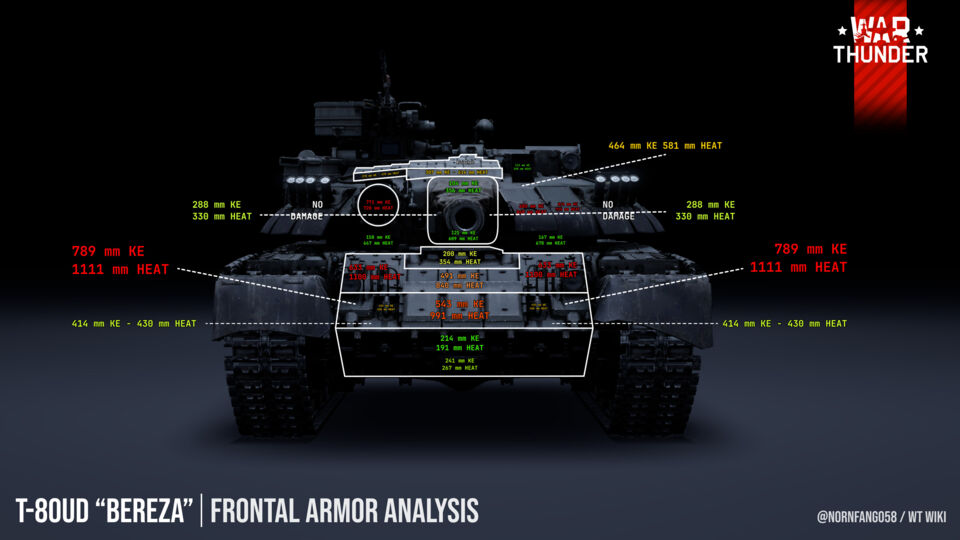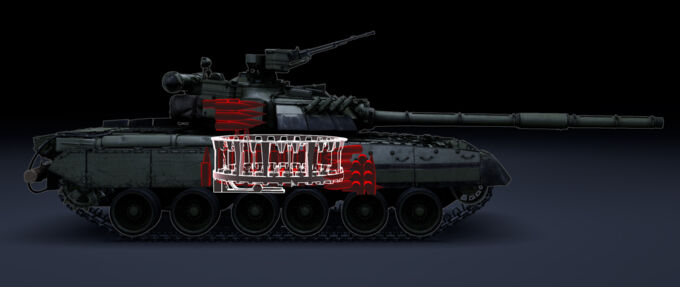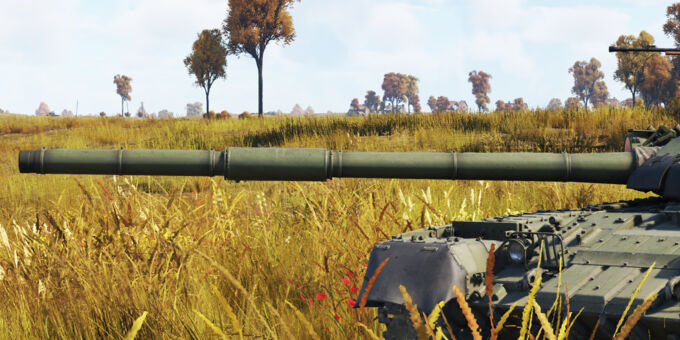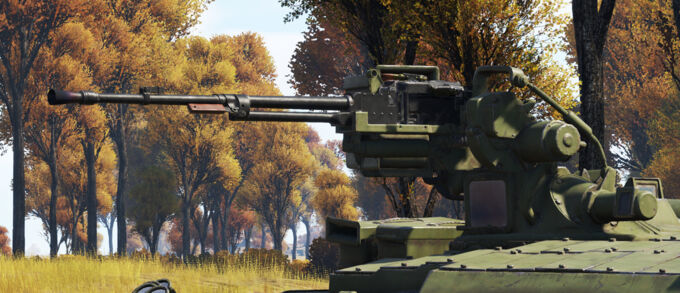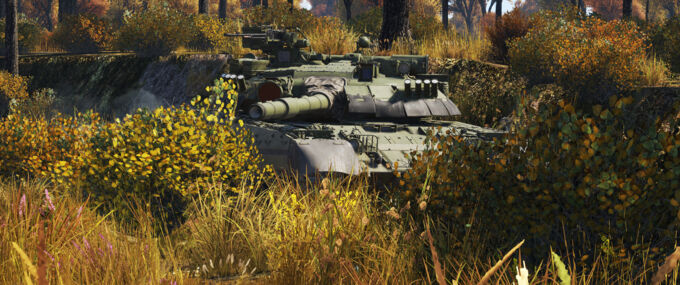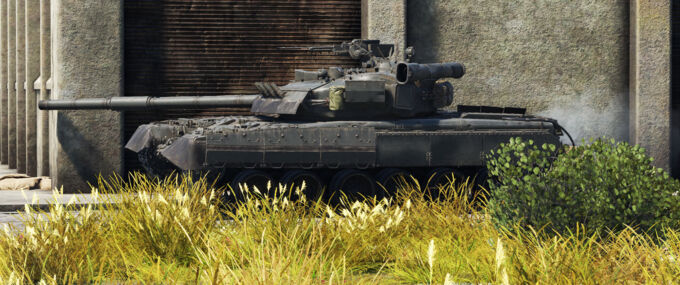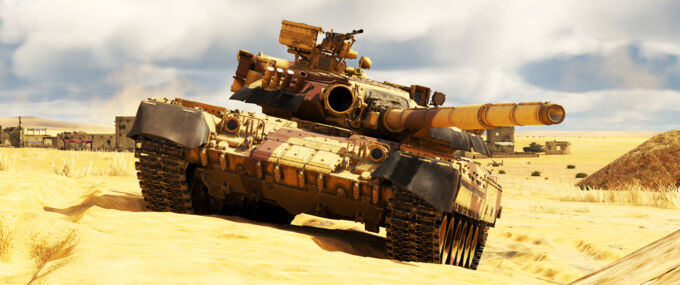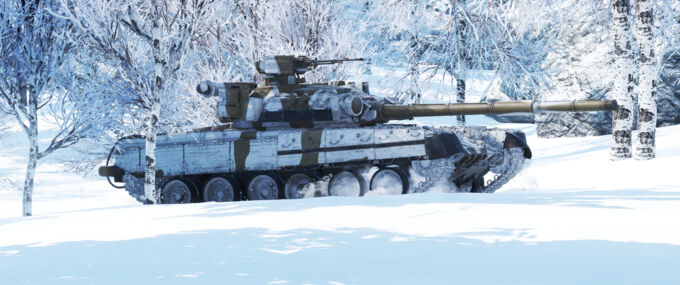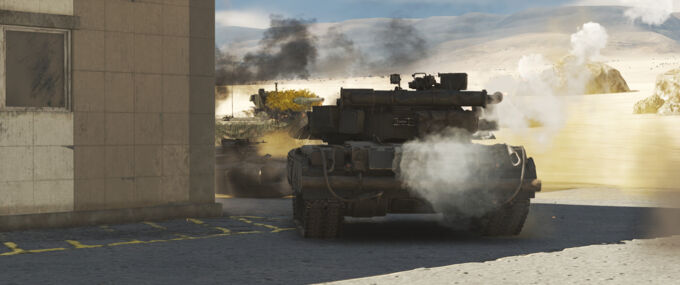The T-80UD Bereza is a development of the venerable T-80U main battle tank. Concerned with the gas-guzzling tendencies of T-80's gas turbine engine, Soviet designers replaced the turbine engine on the T-80U with a new 1,000 hp diesel engine.
| Pros | Cons |
|---|---|
| Excellent frontal armor with composite and Kontakt-5 heavy ERA | Poor survivability due to the cramped interior |
| Potent 125 mm gun and “Mango” APFSDS | 5 km/h reverse speed is very unforgiving |
| Consistent 6.5 second reload thanks to the carousel autoloader | Only 3 crew members, 1 less than most Western or NATO MBTs |
| Great mobility over all types of terrain | No thermals for the gunner or commander |
Differences between the T-80U/UD
Besides the new diesel engine, there are a few differences between the T-80U and UD. However, these differences do not significantly affect the usage (or playstyle) of the tank, and the T-80UD still performs very much like the T-80U and retains the same strengths and weaknesses.
Main differences
- Inferior reverse speed (5 vs 11 km/h) and power-to-weight ratio (21.74 vs 27.17 hp/ton) due to the different engine and transmission.
- The T-80UD only has standard NVD and image intensification while the U has access to 1st Generation thermals.
- The T-80UD uses the 3BM42 “Mango” round while the T-80U has access to the improved 3BM46 “Svinets” round with more penetration.
- The T-80UD has a slightly weaker upper frontal plate (or UFP), with the T-80U having a 50-30-50-30-50 armor layout of textolite and HHRA in millimeters, while the T-80UD has a 50-30-35-30-50 layout.
The most noticeable differences are the poor reverse speed and the lack of thermal imaging technology. In close quarters combat, the 5 km/h reverse speed can be unforgiving when needing to retreat. Additionally, the lack of thermals makes spotting targets more difficult at longer distances and in dense brush.
Armor and survivability
Maintaining the same armor layout as the T-80U at a much lower battle rating, the T-80UD has effective armor against both KE and HEAT weaponry, and enemies will find the T-80UD to be a tough nut to crack if they do not aim for the tank’s weakspots. However, the post-penetration survivability of the T-80UD is rather lackluster and most penetrating shots will either disable the autoloader or detonate the ammo.
Armor
Below is a diagram of the T-80UD’s armor effectiveness against both APFSDS (KE) penetrators and HEAT munitions. Protection values are listed in millimeters (mm). The armor values are based on when the Kontakt-5 ERA is intact.
The majority of the front and turret of the tank is covered with Kontakt-5 ERA. Unlike traditional ERA such as Blazer or Kontakt-1 which only work against HEAT, Kontakt-5 also is effective against APFSDS and other types of kinetic penetrators, providing 120 mm of protection against KE and 450 mm of protection against HEAT. Note that Kontakt-5 will only provide protection against one hit before falling off, since all types of ERA (excluding NERA and SLERA) are only effective against a single shot.
Warning: The Kontakt-5 ERA provides a significant amount of protection against HEAT and APFSDS rounds. Once the Konakt-5 is stripped away, the armor’s effectiveness is reduced, especially against ATGMs with high penetration.
Internal composite armor protect the Upper Frontal Plate (or UFP) of the tank and the frontal areas of the turret. The UFP is composed of HHRA, textolite, and air. The turret composite contains cast homogenous armor, cellular armor, and HHRA.
Frontal weakspots
- Lower Frontal Plate, or LFP
- Driver port
- Gun breech
The side armor of the T-80UD (and all T-72/80/90 tanks) is relatively weak. There is some Kontakt-5 protecting the forward-most area of the tank where the driver is located, but most HEAT and APFSDS rounds will penetrate the side armor without difficulty. Avoid exposing the side armor when possible.
Survivability
The T-80UD has relatively poor survivability due to its cramped interior, low crew count, and the large autoloader carousel which is easy to disable and detonate. The weakspots of the T-80UD are small and somewhat hard to hit, but a successful penetration will most likely destroy or cripple the tank.
Due to Soviet tank doctrine and the emphasis on small size and low profile, there are only 3 crew members in the T-80: the commander, gunner, and driver. Most Western and NATO MBTs have 4 crew members which. To destroy a tank with a four-person crew, at least three crew members must be eliminated. However, for the T-80UD, only two crew members need to be eliminated for the tank to be considered destroyed.
Shots that penetrate the driver’s port will usually disable the breech and also kill the commander, gunner, and driver, resulting in a crew knockout. Shots that hit the LFP will disable the ammo carousel and potentially detonate the fuel tanks or ammo. The interior fuel tanks are a double-edged sword, as they can sometimes eat the spall from HEAT and KE rounds but also may explode after being hit.
Mobility
The T-80UD is powered by a traditional diesel engine unlike the rest of the T-80 family which use a more powerful gas turbine powerpack.
Even with the less powerful diesel engine, the T-80UD has an excellent power-to-weight ratio of 21 hp/ton and can negotiate nearly all types of terrain without issues. The tank will typically travel at 30 to 40 km/h on uneven surfaces and can go as fast as 60 km/h on paved roads and streets.
The only issue mobility-wise is the very poor reverse speed of 5 km/h. Manually traversing the entire tank around and then driving off can be a quicker way to change direction, but this may not be feasible in combat scenarios. However, even turning in place can be tedious because of the lack of neutral steering.
The T-80UD can also create a smoke cloud using its engine via the ESS feature.
Armaments
The T-80UD’s primary weapon is the Soviet 125 mm 2A46M-1 smoothbore cannon. The 2A46M-1 is able to fire AFPSDS, ATGMs, HE, and HEAT rounds, and is also equipped with a laser rangefinder to quickly measure and set the necessary vertical lead required to hit targets. A 12.7 mm NSVT machine gun is mounted on the commander’s cupola to deal with low-flying aircraft and lightly armored vehicles, and a coaxial 7.62 mm PKT machine gun is mounted next to the main cannon.
Additionally, there are 81 mm smoke grenades mounted on the front of the turret, with 4 grenades on each side (8 grenades in total). These can be used to provide instantaneous cover and to block sightlines when retreating or advancing.
125 mm 2A46M-1 smoothbore cannon
Found on all variants of the T-80 and also on the T-64B, the 2A46M-1 cannon is a cornerstone of Soviet and Russian tank firepower. The gun is loaded by a 28-round carousel autoloader with a consistent 6.5 second reload rate.
The 2A46M-1 has poor gun depression (-5°) due to the small turret and low profile of the T-80UD. Due to this, aiming from hilly positions is quite difficult and the T-80UD cannot use reverse-hill tactics effectively.
Available ammunition options
3BM42 (Mango) — APFSDS
The best anti-tank ammunition is the 3BM42 “Mango” sabot round, which can penetrate up to 457 mm of armor at 10 m. It has good ballistics with very little shell drop, travels at 1700 m/s, and is quite easy to aim, even without the laser rangefinder. Mango also produces a good amount of spall (post-penetration damage), so most targets can be destroyed in a single well-aimed shot.
In downtiers, aiming for weakspots is generally not required as Mango has sufficient penetration to frontally penetrate most common MBTs, like the M60 and Challenger Mk.2. In uptiers however, tanks like the Leopard 2s and M1 Abrams have a significant amount of armor that can stop Mango, so players should begin to familiarize themselves with weakspots of common MBTs.
9M119 — ATGM
Although the 9M119 ATGM is not as useful as Mango for ground combat, it can be used to good effect against helicopters. Having a steady hand while aiming and not making sudden movements will increase the likelihood of a successful kill.
3OF26 — HE
The 3OF26 HE round can be used to overpressure tanks and light vehicles. When using it against MBTs, aim for the turret ring or roof optics.
3BK18M — HEATFS
Even though 3BK18M performs decently well against MBTs, the prevalence of composite armor and ERA negatively affects the performance of this round. Avoid this and take Mango instead for anti-tank duties, or 3OF26 for light vehicles.
12.7 mm NSVT
The NSVT machine gun is mounted on the commander’s hatch. It is very similar to the American M2HB Browning, but the NSVT has a higher fire rate of fire. It can easily cripple low flying aircraft and even some light vehicles that have thin armor.
7.62 mm PKT
The PKT machine gun is mounted as a coaxial MG next to the 2A46M-1 cannon. It has measly penetration and cannot damage nearly all targets that the T-80UD will face, so it is only useful for mowing down small obstacles or for pinging targets.
Recommended loadout
- Ammo: 22×3BM42 (Mango) for general use, 3×3OF26 for light targets
- Camouflage: Default/Deforming tricolor for forests/grasslands, Late green for urban areas, Bicolor desert for deserts, and Deforming winter for snowy terrain.
Note: The “Late green camouflage” is actually black in color, despite it being called “Late green”.
Usage in battles
Whether it be sniping, brawling, or flanking, the T-80UD can easily adapt to most combat scenarios thanks to its good mobility and powerful armament.
Warning: No matter what, do not overextend. The 5 km/h reverse will make quick retreats near-impossible.
Sniping
The main difficulties that tankers will run into when attempting to snipe in the T-80UD are the lack of thermals and the less-than-ideal gun depression. However, the T-80UD can be very annoying to kill at longer distances due to its small weakspots. The Kontakt-5 on the turret and UFP will be more than enough to stop AFPSDS rounds.
When sniping, the best position to be in is with the hull hidden and only the turret exposed. This is also known as a hull-down position. With the turret exposed, the only weakspots for enemies to shoot are the gun breech and the turret ring. Make sure to wiggle the turret to decrease the chances of a shell hitting the gun or gun breech.
Tip: Ever had that pesky hull-down light tank that keeps slinging its ATGMs across the map at you, and only exposes its tiny missile launcher? Switch from Mango to the HE round, and a hit should immediately overpressure the enemy vehicle.
Binoculars and the commander’s sight should be used to spot enemy tanks while behind cover. The laser rangefinder (LRF) should be used to precisely aim the gun.
Brawling (CQC) and flanking
When brawling and flanking, the most important thing is to be aware of your surroundings. Listening to engine noises and paying attention to the minimap and team callouts can be the difference between getting a kill or being sent back to the respawn screen. Always be wary of accidentally overextending, as the reverse speed can prove fatal.
The T-80UD’s good engine power can get it to favorable positions or capture points quickly; the T-80UD will be slower than light tanks like the BMP and VBCI but faster than other MBTs like the Merkava and Challenger. Note that the diesel engine is rather noisy, and enemies can easily triangulate the location of the tank after some time (if they are listening).
The composite armor and Kontakt-5 ERA can eat most shots that do not hit the weakspots (driver port, LFP, gun breech) of the tank. Watch out for vehicles that flank to the sides, as side penetrations will most likely detonate the ammo. Nevertheless, the T-80UD can be quite tanky, and especially hard to destroy in downtiers.
With a consistent reload of 6.5 seconds and the reliable Mango APFSDS round, players will find destroying MBTs to be a breeze. Just remember that in uptiers, the penetration of Mango may not be enough to deal with the armor of more modern MBTs, but aiming for the turret ring or LFP should be sufficient.

